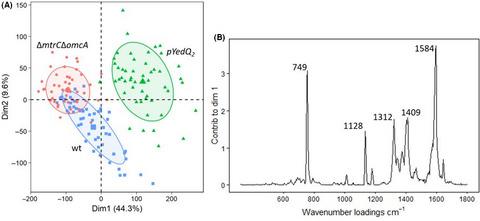当前位置:
X-MOL 学术
›
Microb. Biotechnol.
›
论文详情
Our official English website, www.x-mol.net, welcomes your
feedback! (Note: you will need to create a separate account there.)
Elevated intracellular cyclic-di-GMP level in Shewanella oneidensis increases expression of c-type cytochromes.
Microbial Biotechnology ( IF 4.8 ) Pub Date : 2020-07-30 , DOI: 10.1111/1751-7915.13636 Chun Kiat Ng 1, 2 , Jiabao Xu 1 , Zhao Cai 2 , Liang Yang 2 , Ian P Thompson 1 , Wei E Huang 1 , Bin Cao 2, 3
Microbial Biotechnology ( IF 4.8 ) Pub Date : 2020-07-30 , DOI: 10.1111/1751-7915.13636 Chun Kiat Ng 1, 2 , Jiabao Xu 1 , Zhao Cai 2 , Liang Yang 2 , Ian P Thompson 1 , Wei E Huang 1 , Bin Cao 2, 3
Affiliation

|
Electrochemically active biofilms are capable of exchanging electrons with solid electron acceptors and have many energy and environmental applications such as bioelectricity generation and environmental remediation. The performance of electrochemically active biofilms is usually dependent on c‐type cytochromes, while biofilm development is controlled by a signal cascade mediated by the intracellular secondary messenger bis‐(3ʹ‐5ʹ) cyclic dimeric guanosine monophosphate (c‐di‐GMP). However, it is unclear whether there are any links between the c‐di‐GMP regulatory system and the expression of c‐type cytochromes. In this study, we constructed a S. oneidensis MR‐1 strain with a higher cytoplasmic c‐di‐GMP level by constitutively expressing a c‐di‐GMP synthase and it exhibited expected c‐di‐GMP‐influenced traits, such as lowered motility and increased biofilm formation. Compared to MR‐1 wild‐type strain, the high c‐di‐GMP strain had a higher Fe(III) reduction rate (21.58 vs 11.88 pM of Fe(III)/h cell) and greater expression of genes that code for the proteins involved in the Mtr pathway, including CymA, MtrA, MtrB, MtrC and OmcA. Furthermore, single‐cell Raman microspectroscopy (SCRM) revealed a great increase of c‐type cytochromes in the high c‐di‐GMP strain as compared to MR‐1 wild‐type strain. Our results reveal for the first time that the c‐di‐GMP regulation system indirectly or directly positively regulates the expression of cytochromes involved in the extracellular electron transport (EET) in S. oneidensis, which would help to understand the regulatory mechanism of c‐di‐GMP on electricity production in bacteria.
中文翻译:

Shewanella oneidensis 细胞内环二 GMP 水平升高会增加 c 型细胞色素的表达。
电化学活性生物膜能够与固体电子受体交换电子,并具有许多能源和环境应用,例如生物发电和环境修复。电化学活性生物膜的性能通常依赖于c型细胞色素,而生物膜的发育是由细胞内第二信使双-(3ʹ-5ʹ)环状二聚鸟苷单磷酸(c-di-GMP)介导的信号级联控制。然而,尚不清楚 c-di-GMP 调节系统与c型细胞色素的表达之间是否存在任何联系。在本研究中,我们通过组成型表达 ac-di-GMP 合酶构建了具有较高细胞质 c-di-GMP 水平的S. oneidensis MR-1 菌株,并表现出预期的 c-di-GMP 影响的特征,例如运动性降低并增加生物膜的形成。与 MR-1 野生型菌株相比,高 c-di-GMP 菌株具有更高的 Fe(III) 还原率(Fe(III)/h 细胞为 21.58 pM vs 11.88 pM),并且编码参与 Mtr 通路的蛋白包括 CymA、MtrA、MtrB、MtrC 和 OmcA。此外,单细胞拉曼显微光谱(SCRM)显示,与 MR-1 野生型菌株相比,高 c-di-GMP 菌株中的c型细胞色素显着增加。我们的研究结果首次揭示了c-di-GMP调控系统间接或直接正向调节S. oneidensis中参与细胞外电子传递(EET)的细胞色素的表达,这将有助于理解c-di-GMP的调控机制。 di-GMP 对细菌产电的影响。
更新日期:2020-10-05
中文翻译:

Shewanella oneidensis 细胞内环二 GMP 水平升高会增加 c 型细胞色素的表达。
电化学活性生物膜能够与固体电子受体交换电子,并具有许多能源和环境应用,例如生物发电和环境修复。电化学活性生物膜的性能通常依赖于c型细胞色素,而生物膜的发育是由细胞内第二信使双-(3ʹ-5ʹ)环状二聚鸟苷单磷酸(c-di-GMP)介导的信号级联控制。然而,尚不清楚 c-di-GMP 调节系统与c型细胞色素的表达之间是否存在任何联系。在本研究中,我们通过组成型表达 ac-di-GMP 合酶构建了具有较高细胞质 c-di-GMP 水平的S. oneidensis MR-1 菌株,并表现出预期的 c-di-GMP 影响的特征,例如运动性降低并增加生物膜的形成。与 MR-1 野生型菌株相比,高 c-di-GMP 菌株具有更高的 Fe(III) 还原率(Fe(III)/h 细胞为 21.58 pM vs 11.88 pM),并且编码参与 Mtr 通路的蛋白包括 CymA、MtrA、MtrB、MtrC 和 OmcA。此外,单细胞拉曼显微光谱(SCRM)显示,与 MR-1 野生型菌株相比,高 c-di-GMP 菌株中的c型细胞色素显着增加。我们的研究结果首次揭示了c-di-GMP调控系统间接或直接正向调节S. oneidensis中参与细胞外电子传递(EET)的细胞色素的表达,这将有助于理解c-di-GMP的调控机制。 di-GMP 对细菌产电的影响。











































 京公网安备 11010802027423号
京公网安备 11010802027423号